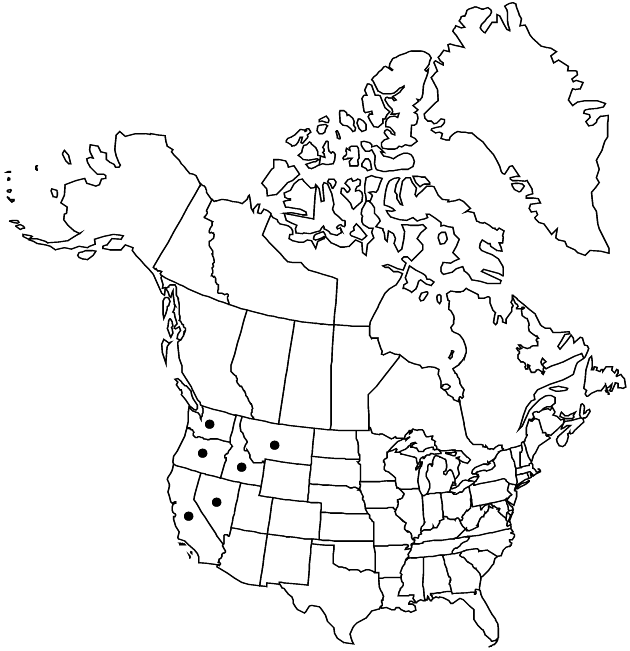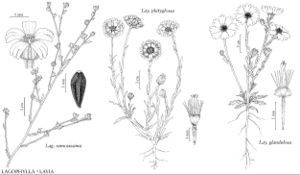Difference between revisions of "Lagophylla ramosissima"
Trans. Amer. Philos. Soc., n. s. 7: 391. 1841.
FNA>Volume Importer |
FNA>Volume Importer |
||
| Line 11: | Line 11: | ||
|name=Lagophylla congesta | |name=Lagophylla congesta | ||
|authority=Greene | |authority=Greene | ||
| + | |rank=species | ||
}} {{Treatment/ID/Synonym | }} {{Treatment/ID/Synonym | ||
|name=Lagophylla ramosissima subsp. congesta | |name=Lagophylla ramosissima subsp. congesta | ||
|authority=(Greene) D. D. Keck | |authority=(Greene) D. D. Keck | ||
| + | |rank=subspecies | ||
}} | }} | ||
|hierarchy=Asteraceae;Asteraceae tribe Heliantheae;Asteraceae (tribe Heliantheae) subtribe Madiinae;Lagophylla;Lagophylla ramosissima | |hierarchy=Asteraceae;Asteraceae tribe Heliantheae;Asteraceae (tribe Heliantheae) subtribe Madiinae;Lagophylla;Lagophylla ramosissima | ||
| Line 29: | Line 31: | ||
|elevation=10–1800 m | |elevation=10–1800 m | ||
|distribution=Calif.;Idaho;Mont.;Nev.;Oreg.;Wash. | |distribution=Calif.;Idaho;Mont.;Nev.;Oreg.;Wash. | ||
| − | |discussion=<p><i>Lagophylla ramosissima</i> occurs widely in dry, often disturbed or poor soils of the California Floristic Province, Great Basin, and Pacific Northwest. Plants with heads in glomerate arrays have been treated as L. congesta or <i>L. ramosissima</i> < | + | |discussion=<p><i>Lagophylla ramosissima</i> occurs widely in dry, often disturbed or poor soils of the California Floristic Province, Great Basin, and Pacific Northwest. Plants with heads in glomerate arrays have been treated as L. congesta or <i>L. ramosissima</i> <i></i>subsp.<i> congesta</i>; W. C. Thompson (1983, p. 21) concluded that L. congesta represents an “extreme morphological variant of <i>L. ramosissima</i>” unworthy of taxonomic recognition.</p> |
|tables= | |tables= | ||
|references= | |references= | ||
| Line 38: | Line 40: | ||
-->{{#Taxon: | -->{{#Taxon: | ||
name=Lagophylla ramosissima | name=Lagophylla ramosissima | ||
| − | |||
|authority=Nuttall | |authority=Nuttall | ||
|rank=species | |rank=species | ||
| Line 53: | Line 54: | ||
|publication year=1841 | |publication year=1841 | ||
|special status= | |special status= | ||
| − | |source xml=https://jpend@bitbucket.org/aafc-mbb/fna-data-curation.git/src/ | + | |source xml=https://jpend@bitbucket.org/aafc-mbb/fna-data-curation.git/src/eaa6e58056e40c9ef614d8f47aea294977a1a5e9/coarse_grained_fna_xml/V19-20-21/V21_643.xml |
|tribe=Asteraceae tribe Heliantheae | |tribe=Asteraceae tribe Heliantheae | ||
|subtribe=Asteraceae (tribe Heliantheae) subtribe Madiinae | |subtribe=Asteraceae (tribe Heliantheae) subtribe Madiinae | ||
Revision as of 19:38, 16 December 2019
Plants 10–100(–150) cm (plants self-compatible); branching ex-current or ± pseudo-dichotomous, distal stems eglandular. Leaves: blades grayish, mostly eglandular (distal stipitate-glandular abaxially, glands whitish or yellowish; plants otherwise eglandular). Heads in paniculiform arrays or in glomerules. Calyculi of 2–5 bractlets. Involucres obconic to obovoid. Phyllaries 4–7 mm, piloso-hirsute on angles, hairs ± patent to antrorsely curved, 0.5–1+ mm. Ray laminae 3–6 mm. Cypselae dull to ± glossy (weakly striate). 2n = 14.
Phenology: Flowering Apr–Oct.
Habitat: Grasslands, openings in chaparral, scrub, woodlands, and forests
Elevation: 10–1800 m
Distribution

Calif., Idaho, Mont., Nev., Oreg., Wash.
Discussion
Lagophylla ramosissima occurs widely in dry, often disturbed or poor soils of the California Floristic Province, Great Basin, and Pacific Northwest. Plants with heads in glomerate arrays have been treated as L. congesta or L. ramosissima subsp. congesta; W. C. Thompson (1983, p. 21) concluded that L. congesta represents an “extreme morphological variant of L. ramosissima” unworthy of taxonomic recognition.
Selected References
None.
